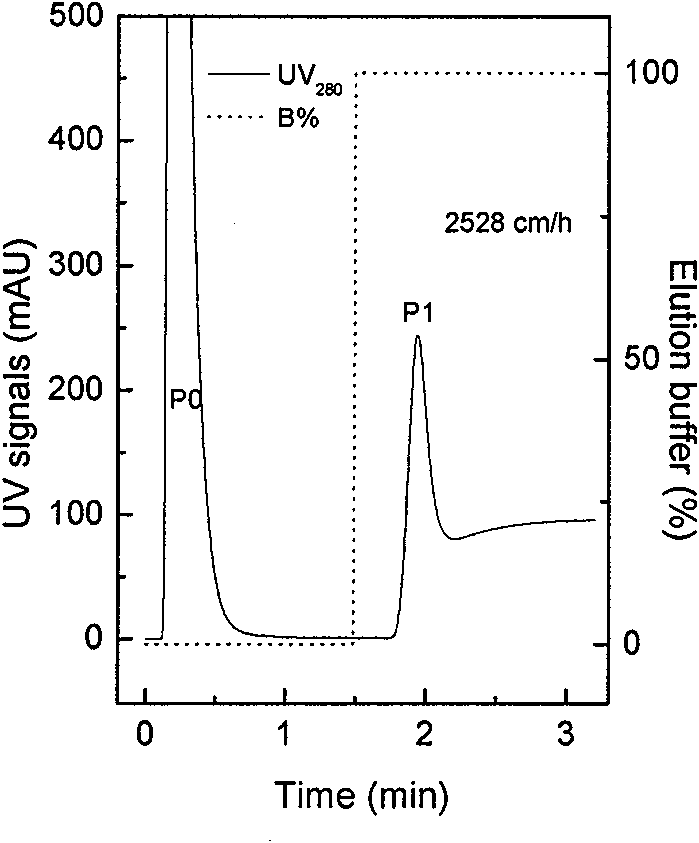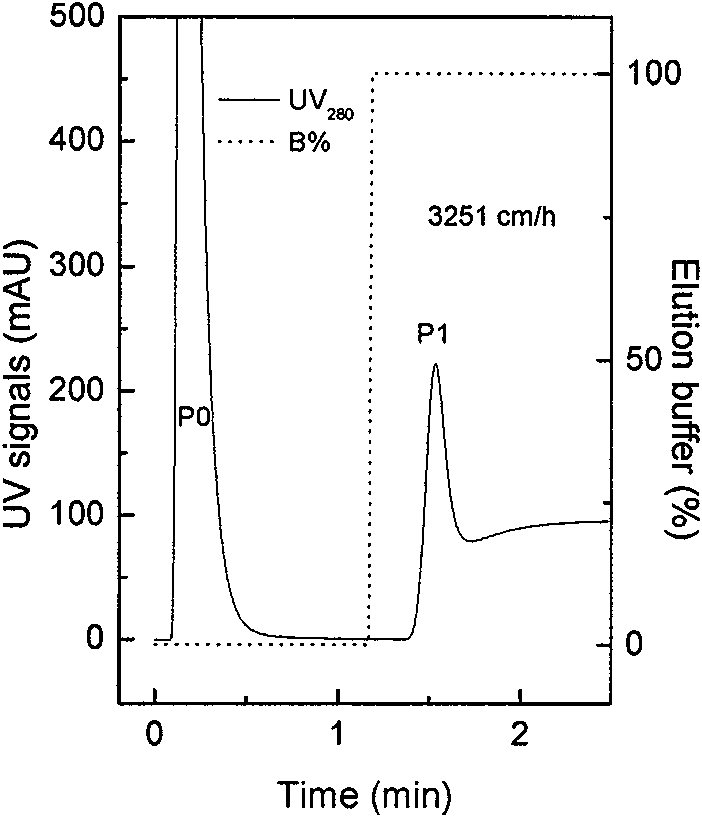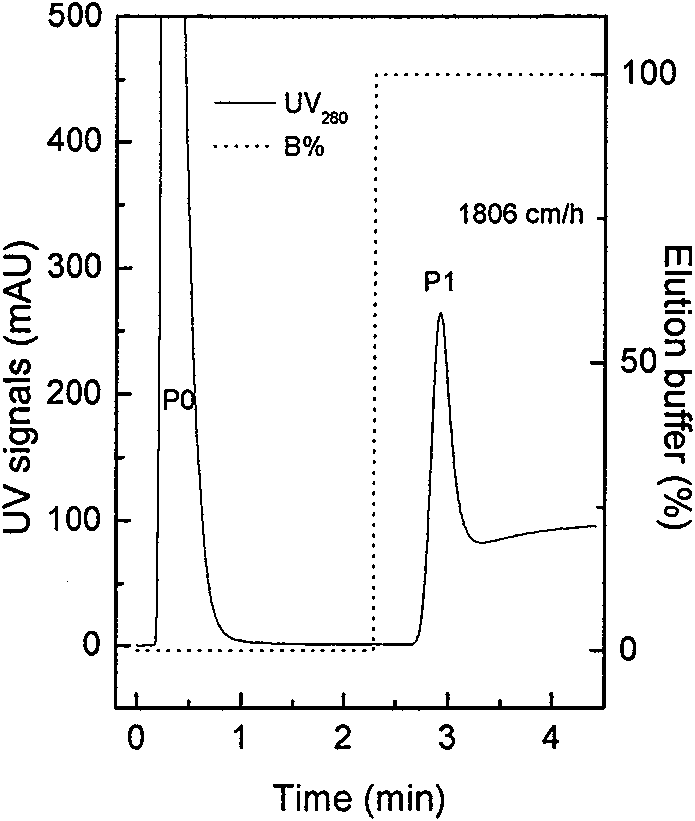Method for quickly preparing recombinant heat-resistant manganese superoxide dismutase
A superoxide and dismutase technology, applied in biochemical equipment and methods, enzymes, enzymes, etc., can solve the problems of less super-large pore media, limitations, and no reports of high-temperature-resistant SOD enzymes, and achieve fast separation speed and recovery The effect of high efficiency and small loss of SOD enzyme activity
- Summary
- Abstract
- Description
- Claims
- Application Information
AI Technical Summary
Problems solved by technology
Method used
Image
Examples
Embodiment 1
[0025] Take 500ml of fermentation broth, centrifuge for 15mm (centrifugation condition is 4°C, centrifugal force is 1000×g), wash the bacteria with 5-10ml of 1M TE Buffer (pH 8.0), centrifuge for 15min, discard the supernatant, add 1M TE Buffer (pH 8.0) TE Buffer (pH 8.0) 5ml, mix well; use an ultrasonic cell pulverizer to crush the bacteria (ultrasonic conditions: ultrasonic time 2s, interval 3s, frequency 99 times); after ultrasonication, centrifuge for 15min, the supernatant is the crude enzyme liquid. Get 5ml of crude enzyme solution, utilize sample loader to load the sample, in the semi-preparative grade ultra-large hole nickel column (300 * 10mm I.D.) that is housed Chromatographic separation on purifier 100system, separation conditions: mobile phase, 20mM phosphate buffer + 0.5M NaCl + 0.12M imidazole, pH 7.4; elution phase, 20mM phosphate buffer + 0.5M NaCl + 0.5M imidazole, pH 7.4; Elution mode, step elution; operating flow rate, 2528cm / h. Collect the elution peak ...
Embodiment 2
[0027] Take 500ml of fermentation broth, centrifuge for 15min (centrifugation condition is 4°C, centrifugal force is 1000×g), wash the bacteria with 5-10ml of 1M TE Buffer (pH 8.0), centrifuge for 15min, discard the supernatant, add 1M TE Buffer (pH 8.0) TE Buffer (pH 8.0) 5ml, mix well; use an ultrasonic cell pulverizer to crush the bacteria (ultrasonic conditions: ultrasonic time 2s, interval 3s, frequency 99 times); after ultrasonication, centrifuge for 15min, the supernatant is the crude enzyme liquid. Get 5ml of crude enzyme solution, utilize sample loader to load the sample, in the semi-preparative grade ultra-large hole nickel column (300 * 10mm I.D.) that is housed Chromatographic separation on purifier 100system, separation conditions: mobile phase, 20mM phosphate buffer + 0.5M NaCl + 0.1M imidazole, pH 7.4; elution phase, 20mM phosphate buffer + 0.5M NaCl + 0.5M imidazole, pH 7.4; Elution mode, step elution; operating flow rate, 3251cm / h. Collect the elution peak ...
Embodiment 3
[0029] Take 500ml of fermentation broth, centrifuge for 15min (centrifugation condition is 4°C, centrifugal force is 1000×g), wash the bacteria with 5-10ml of 1M TE Buffer (pH 8.0), centrifuge for 15min, discard the supernatant, add 1M TE Buffer (pH 8.0) TE Buffer (pH 8.0) 5ml, mix well; use an ultrasonic cell pulverizer to crush the bacteria (ultrasonic conditions: ultrasonic time 2s, interval 3s, frequency 99 times); after ultrasonication, centrifuge for 15min, the supernatant is the crude enzyme liquid. Get 5ml of crude enzyme solution, utilize sample loader to load the sample, in the semi-preparative grade ultra-large hole nickel column (300 * 10mm I.D.) that is housed Chromatographic separation on purifier 100system, separation conditions: mobile phase, 20mM phosphate buffer + 0.5M NaCl + 0.1M imidazole, pH 7.4; elution phase, 20mM phosphate buffer + 0.5M NaCl + 0.1M imidazole, pH 5; Elution mode, step elution; operating flow rate, 1806cm / h. Collect the elution peak ( ...
PUM
| Property | Measurement | Unit |
|---|---|---|
| pore size | aaaaa | aaaaa |
| particle diameter | aaaaa | aaaaa |
| pore size | aaaaa | aaaaa |
Abstract
Description
Claims
Application Information
 Login to View More
Login to View More - R&D
- Intellectual Property
- Life Sciences
- Materials
- Tech Scout
- Unparalleled Data Quality
- Higher Quality Content
- 60% Fewer Hallucinations
Browse by: Latest US Patents, China's latest patents, Technical Efficacy Thesaurus, Application Domain, Technology Topic, Popular Technical Reports.
© 2025 PatSnap. All rights reserved.Legal|Privacy policy|Modern Slavery Act Transparency Statement|Sitemap|About US| Contact US: help@patsnap.com



